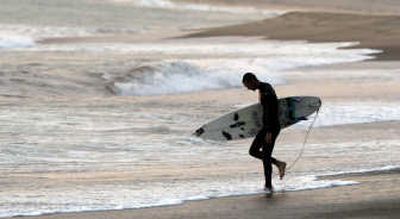Costly oil hits surfers

SAN CLEMENTE, Calif. – For years, Chris Mauro took a 10-mile detour on his way to work each morning to check out the swells at his favorite surf break and plot the best location for his afterwork wave-riding. But with gas now approaching $5 a gallon in California, Mauro recently cut out his daily ritual in favor of the savings.
He isn’t alone.
The surging cost of oil has been a dose of reality for many surfers who have long thought of their sport, with all its sun-kissed lore, as a counterculture niche shielded from the pressures of mainstream America.
The industry depends on petroleum-based products to build and ship its boards. And surfers in search of the biggest waves have to dig deeper into their pockets to fill their gas tanks or book flights to the best breaks around the world, including far-flung places like South Africa and Tahiti.
“We all think about oil in our cars, but very few of us really consider the fact that every little piece of manmade equipment around you is oil-based, and surfing’s no different,” said Mauro, who’s seen the price of some surfboards double to $750 or higher.
“The price of a surfboard, it used to be something where it was pretty digestible. Now, it’s like, whoa, OK, I’ve got to put some serious thought into this.”
Until now, surfing – with all its trendy clothing and gear – has been one of the fastest-growing sports industries in the nation.
In 2006, independent retailers of surf gear brought in $2.65 billion in revenue, up from $2.46 billion two years before. Meanwhile, U.S. retail sales of surfboards jumped from $106 million in 2004 to more than $190 million in 2006, according to the Surf Industry Manufacturers Association.
Industry numbers for 2007-2008 aren’t yet available, but some retailers and manufacturers say they expect that rapid sales growth to slow after seeing drops approaching 30 percent in their own operations.
Some predict the tough economic times will take a heavier toll on family-run surfboard workshops – once the mainstay of the industry – than on the large, national board makers such as Channel Islands, Lost Enterprises, Dewey Weber Surfboards and Surftech.
The smaller operations are struggling with the rising cost of petroleum-based resin used to coat surfboards. They also face lagging orders from mainstream retailers that tend to bypass regional board brands when times are tough.
Peter St. Pierre, who owns Moonlight Glassing in San Marcos, Calif., has seen the cost of resin jump 30 percent to $1,000 for a 50-gallon drum in the past year, squeezing his profit margins when money is already tight.
“If we can break even this year, I’ll be happy,” said St. Pierre, who recalls a similar crisis during the oil embargo in the 1970s.
“It’s a trade-off of being able to do something you love, with your hands, and being able to go out and go surfing instead of just punching the clock,” he said.
Mark Wooster, owner of Wooster Surfboards in New Smyrna Beach, Fla., said his retail sales have dropped about 20 percent this year after previous years of 40 percent growth.
Major surf and skate retailer Ron Jon hasn’t ordered any of Wooster’s boards for its California stores for a year because of lagging sales, he said.
Wooster, who produces about 1,000 custom-made boards in a good year, is convinced he can’t raise prices because of competition from cheaper, mass-produced imports.
U.S. bookings to exotic surf spots in Asia have dropped 20 percent as airfares soar as high as $2,500 to places such as Sumatra, said Sean Dunlap, sales manager at Wave Hunters, a specialty surf travel agency in San Diego. Many airlines have added or increased excess luggage fees that can add hundreds of dollars to a plane ticket for surfers with board bags.
Some surfers are using the Internet to find good surf instead of driving around until they spot it themselves.
Web sites with surf cameras have reported an uptick in users, said Mike Matey, vice president of marketing at Huntington Beach-based surfline.com.
Webcam traffic is up 10 percent at his site, which has cameras positioned at 135 prime locations worldwide. He also said subscriptions to the site’s premium Web service have jumped 17 percent. Similar sites reported increases of 10 to 12 percent in Web camera traffic.
Other surfers said they are hitting the beach less often, cutting back on long drives or eliminating trips when they aren’t sure in advance the waves will be great.
Seattle surfer Whare Heke, 40, has cut out day excursions to the beach because of the cost of the 270-mile roundtrip.
“We’ve been doing a lot more hiking,” he said.